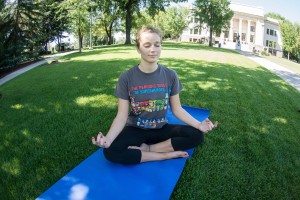
Laura Harper interned at the Utah State Hospital where she worked with borderline personality disorder patients and taught them meditation and visualization. She began one lesson in visualization by having the patients imagine a band of light moving down their bodies, thinking about the sensations they felt. However, the exercise did not go quite as planned.
“We opened our eyes a few minutes later, and I found a couple of female patients looking confused and traumatized,” Harper said.
The meditation that Harper was trying to teach the patients is called mindfulness.
Mindfulness is making a comeback as a therapeutic technique used to improve anxiety and other mental illnesses. Mindfulness emphasizes living in the moment and being at peace with the current situation. Although it is being utilized mostly for therapeutic purposes, everyone is capable of being mindful.
However, Western culture generally finds it harder to implement mindfulness into daily life, as it is more socially acceptable to reject uncomfortable feelings rather than acknowledging the feelings and accepting them.
Harper, now a mindfulness yoga instructor in Provo, first learned of mindfulness as a graduate student at BYU.
“I was pleased to discover that mindfulness was, in fact, a respected and rapidly growing therapeutic modality brought into the mainstream by Jon Kabat-Zinn with his Mindfulness Based Stress Reduction Program,” Harper said.
Studies continue to prove that mindfulness results in stress reduction, according to a UCLA summary of mindfulness research. Everyone can benefit from the positive effects of mindfulness.
“Learning to observe oneself in a curious, compassionate way is the beginning of a healthy change,” Harper said. “Everyone benefits from self-awareness.”
Mindfulness is even becoming a part of pop culture, according to Tiffany Roe, a counselor at Mindful Counseling in Orem.
“It seems to have become this kind of buzzword,” Roe said. “Kind of a trendy topic at this point.”
Although the concept is gaining popularity, implementing mindfulness is proving to be difficult in the Western hemisphere. Roe described the U.S. as having an individualistic culture.
“We value achievement, independence and showing strength,” Roe said. “And so we say that uncomfortable emotions are weakness.”
It is far more common for people to look for a way to get rid of the uncomfortable feelings, rather than feeling them and coming to terms with them.
Jacob Hess, a Mindfulness Based Stress Reduction Instructor in Salt Lake City, confirmed that the mindful approach can be difficult for people.
“They do have a tendency to either reject uncomfortable feelings or try to push them or numb them out,” Hess said. “The mindful approach is to turn towards them.”

People will turn to other outlets to try to deal with their emotions, such as food, drugs, work and television. However, these are unhealthy ways to deal with emotions and it can cause the emotions to continue to come back and even worsen, experts say. Hess explained the simplicity of the mindful approach to uncomfortable feelings.
“It’s really about sitting,” Hess said. “Allowing ourselves to feel what we’re feeling.”
With these other tactics of dealing with emotion, there is force involved because feelings are being fought and ignored. Mindfulness does the opposite; it is acceptance without fighting.
“There’s a gentleness to mindfulness,” Hess said. “We need to actually understand what’s going on, accept what’s going on and then we can learn from it.”
Evidence has shown that mindfulness increases positive effects and decreases anxiety and negative effects, according to the American Psychological Association.
Annabella Hagen, a psychologist specializing in anxiety disorders in Provo, said a lot of people come in wanting a quick solution or easy fix for their anxiety.
“In my experience with work, I treat a lot of anxiety disorders,” Hagen said. “They want a fix. They say ‘Give me some relaxation skills so I can feel better.’ That’s not mindfulness.”
Mindfulness is a way of life and is not simply given to individuals. It is a change in mindset and in one’s thought process. It is being at peace with the current moment. It is allowing things to happen as they are without trying to change or fight them.
Harper said she believes Western culture needs to learn to sit still and feel emotions that need to be addressed.
“Sometimes you’re going to feel uncomfortable things,” Harper said. “And that’s okay.”
Harper has continued to teach mindfulness and has increased her awareness of her clients since interning at the Utah State Hospital.
“Since then I have continued to teach mindfulness to all of my clients and have definitely improved at gauging client needs,” Harper said. “Some can hardly close their eyes and follow their breath without becoming uncomfortable and anxious. And others can go quickly and deeply into mindfulness exercises.”
Harper’s awareness of others’ needs allows her to teach mindfulness at a level in which the client is comfortable.
“I just work with wherever they are at,” Harper said. “Introducing this practice of paying attention to what is happening in the moment without judging, analyzing or needing to fix it — just noticing.”




